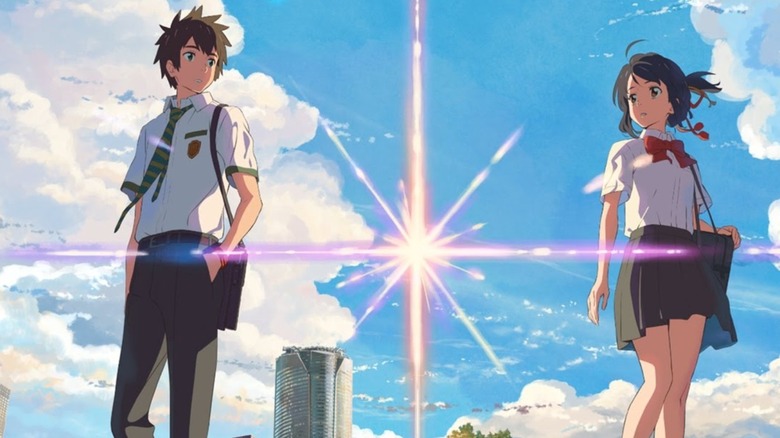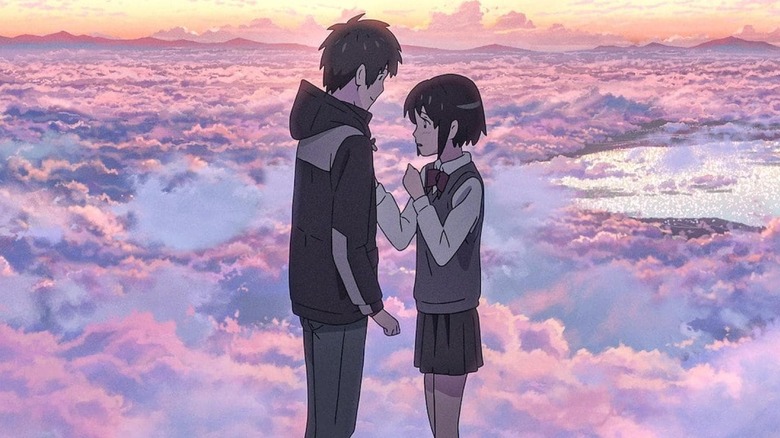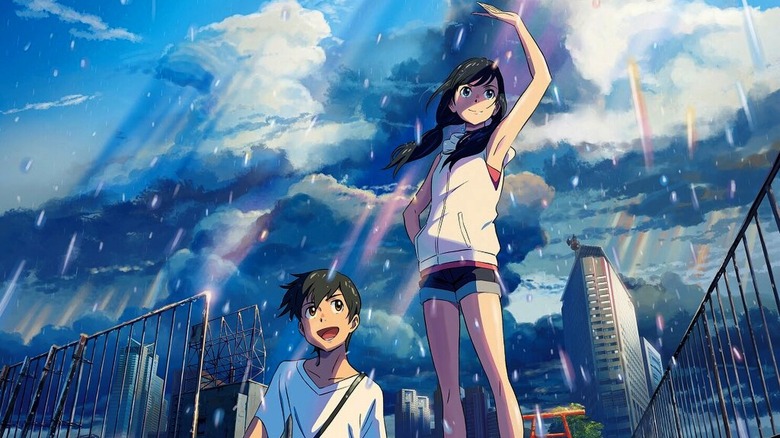Makoto Shinkai's Your Name Was Partly Inspired By This Real-Life Disaster
One of the most exciting anime directors working right now is Makoto Shinkai. Shinkai began his animation career in video games but soon migrated to filmmaking with the 1999 original video animation "She And Her Cat." Since then, Shinkai has directed six features. His greatest success was without a doubt the 2016 fantasy romance film "Your Name."
"Your Name" follows two teenage strangers, Tokyo native Taki and country girl Mitsuha, who begin swapping bodies with each other. One day they'll wake up in their own bodies; the next they'll be in the other's. Once they realize what's happening, the two start to communicate by leaving behind notes for each other. As a most unusual relationship blossoms, Taki discovers he must save Mitsuha from a horrible fate. Shinkai pulled from many inspirations to make the film, from art to real-life tragedy.
The earthquake
The twist in "Your Name" comes when Taki and Mitsuha stop swapping bodies. The film then starts following solely Taki's perspective, as he discovers that his and Mitsuha's timelines weren't parallel. While he lived in 2016, she was in 2013, the same year her town, Itomori, was wiped out by a comet. Taki manages to engineer one last body switch and rewrite history so Itomori's citizens evacuate before the town's destruction. The pair briefly meet each other in person, but they forget each other afterward. Not to worry — they meet each other in Tokyo in 2021 and vaguely recognize each other.
In an interview with Vice, Shinkai explained his inspirations. They ranged from Christopher Nolan's "Interstellar" to a waka poem by ancient Japanese writer Ono no Komachi: "I met someone in my dream, and had I known it was a dream, I would have stayed there." As for the destruction of Itomori, that came from a much more tragic place: the 2011 Tōhoku earthquake that ravaged Japan.
At magnitude 9.0, Tōhoku is the worst earthquake in recorded Japanese history. The damage was threefold; the earthquake caused a tsunami and a meltdown at the Fukushima Daiichi Nuclear Power Plant. The disaster left 18,000 dead, and the effects are still felt in Japan today. On how the earthquake specifically influenced "Your Name," Shinkai said:
"It was the largest in a thousand years, and there was something similar 1,000 years ago, which we all forgot about. But if you look closer there were warnings, like stone inscriptions in the cave in the film: Don't live in this valley. But we forget those warnings, or dismiss them as something 'from the ancient times'. We think they're just dangers from the past. When we have a disaster in Japan, I wonder, how can we prevent our lives and traditions and history from the disaster?"
Weathering With You
Makoto Shinkai's next film was "Weathering With You." On the surface, the films are quite similar. They're both stories about puppy love. They're both set in contemporary Japan with a fantasy backdrop. They both involve a natural disaster. Taki and Mitsuha even cameo in "Weathering With You," confirming the films share a common setting. However, the two stories are spiritually inverted.
After running away to Tokyo, young Hodaka meets Hina, a "sunshine girl" with the ability to control the weather. However, sunshine girls must give up their mortal lives; otherwise Tokyo will be doomed to unending rain storms. Hodaka literally pulls Hina back to Earth, deciding any sacrifice is worth being with her.
On the surface, this is quite similar to Taki's actions in the climax of "Your Name," defying the will of the universe to save his love. However, the effects are the opposite. While Taki saves a town's worth of people, Hodaka damns Tokyo to save Hina. Hodaka's decision is definitely the more selfish one, but the film's ending, where he and Hina reunite as Tokyo has become mostly submerged, illustrates the film's message: Hold onto the things you love even as the world gets worse. This is, unfortunately, a truer-to-life message than trying to undo what's already happened, like in "Your Name."


